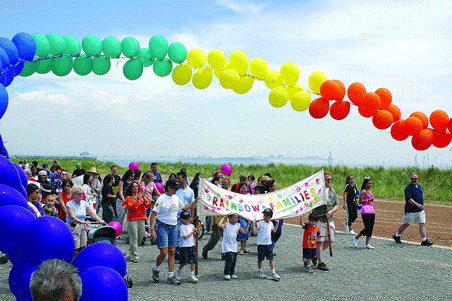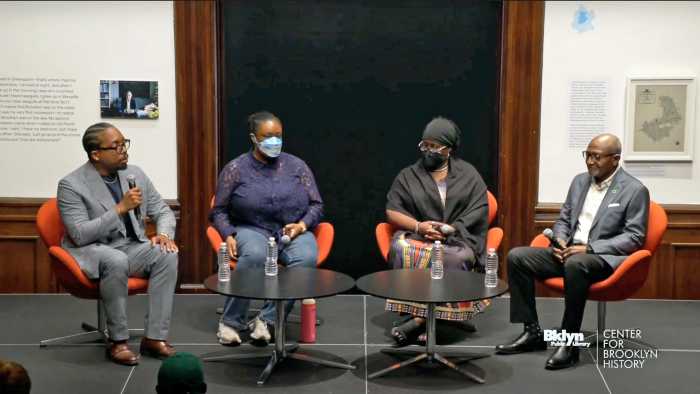Borough Holds Its First LGBT Parade, Festival Under Spectacular Skies
Last Saturday afternoon, as balmy sunshine banished the morning’s threat of continual rain showers, another historic New York City event unfolded—Staten Island’s first gay pride parade. By late morning, near the promenade on Midland Beach, a panoramic stretch with seaward views of New York Harbor and the Verrazano-Narrows Bridge, over 400 marchers gathered on one June day to celebrate what has become a month-long recognition of the achievements and struggles for equality of the world’s gay, lesbian, bisexual and transgender community.
For the members of the Staten Island branch of the clan, June 4 could not arrive soon enough.
Nearly 36 years after the Stonewall riots and subsequent years’ gay liberation marches on Manhattan’s more fabled thoroughfares, Staten Island saluted its gay and lesbian citizens, many of whom still travel to more established gay venues, like Greenwich Village, in order to be totally open.
Nevertheless, Saturday’s festivities—despite one incident that resulted in the arrest of a young man on a bias charge—unfolded as expected with the gay residents of perhaps the city’s most politically recalcitrant borough proudly celebrating their heritage. Not unlike other important cultural and ethnic parades, a score of political aspirants joined grass-roots activists, many of whom work in AIDS services, and representatives from a host of citywide queer organizations, like GOAL, the Gay Officers Action League, and Dignity NY, the gay Catholic group, in making the relatively short promenade march to a park where speakers, musicians and performers entertained the crowds into the night.

Parade participants included a sizable number of gay and lesbian parents and their families. Victoria Fosella, the sister of Congressman Vito Fosella, the only Republican in the city’s congressional delegation and oft-mentioned mayoral aspirant, and Ms. Fossella’s partner, Maggie Scharsella, marched the route with their twins, 1-year-old Jake and sister Karlie, to whom Ms. Scharsella gave birth.
On Saturday, Democratic borough president candidate John Luisi showed up on the promenade before his church wedding, as did fellow Democrats Fernando Ferrer, the former borough president of the Bronx—which has a pride health day on June 18—and Rep. Anthony Weiner, contenders for their party’s mayoral nomination, as well as Assemblyman John Lavelle and State Senator Diane Savino
James Smith, 64, a Staten Island native and longtime gay activist, was this year’s grand marshal. “My first reaction, when they asked me to do this, was, ‘I can’t do this,’” said Smith. The state prison counselor said he spoke to his boss, the superintendent of the Arthur Kill Prison, and asked him if he would be fired if he led the parade. “I’m a state employee so they can’t fire me,” said Smith. “On Monday morning, some of the inmates even congratulated me, seeing me in the paper I suppose,” said Smith with a note of self-effacement, before adding, “I still think it’s 1960 and people are probably more open-minded than I think they are.”
Perhaps perpetuated by the borough’s popular image as a conservative redoubt, Staten Island is not typically thought of as a gay and lesbian community. Long a Republican stronghold, the borough’s votes played a crucial role in the elections of Rudolph Giuliani and his successor, Michael Bloomberg, both of whose administrations have taken staunch positions at odds with gay political goals—from AIDS treatment to pro-gay requirements for city contractors to same-sex marriage.

Nevertheless, certain of the borough’s gays and lesbians related to powerbrokers—like Mr. Fosella’s sister and Robert Molinari, the gay brother of Guy Molinari, a former congressman and borough president—have been outspoken about their sexual orientation and opposition to anti-gay rhetoric, as was Robert Molinari in 1994 when he criticized his brother for saying Karen Burstein, a candidate for attorney general, was unqualified because she was a lesbian.
Though scenic, the parade route was in a remote section of the borough, a criticism raised by some who spoke to the Staten Island Advance, a daily newspaper. “I think for our first parade, where we’re breaking the ice, it’s probably better to have been in this safe kind of area,” said Rosemary Palladino, a co-founder of Stonewall Staten Island.
Jo Ellen Fusco, a Staten Island native and public school teacher, is one of the band members whom Alla allegedly struck. “I saw him zigzagging through the crowd, saying, ‘This isn’t Manhattan. This isn’t Queens. You gays don’t belong here,’” said Fusco, whose partner is also a band member. Alla, said Fusco, knocked her in the head, sending her eyeglasses flying.
Police immediately apprehended the assailant, said Fusco, who praised officers for their diligent and professional response. “We’ve done a lot of parades and nothing like this has ever happened before,” said Fusco. She said that she and her partner were upset that the incident happened on an otherwise celebratory day. “Everybody’s a human being and deserves respect,” said Fusco.

The daylong festivities were organized by Community Health Action of Staten Island, an AIDS services agency.
“We weren’t sure what we were going to get. This is Staten Island,” said Matthew DiPaolo, 22, a parade organizer along with Allyson Sandak, a lesbian colleague at Community Health Action.
“We got a very good community response,” said DiPaolo, adding that one of the most heartening sights was witnessing the participation of older gay and lesbian couples, who turned out for their home borough’s first pride parade. “They were waiting on this day longer than I have been on this Earth.”

gaycitynews.com

































